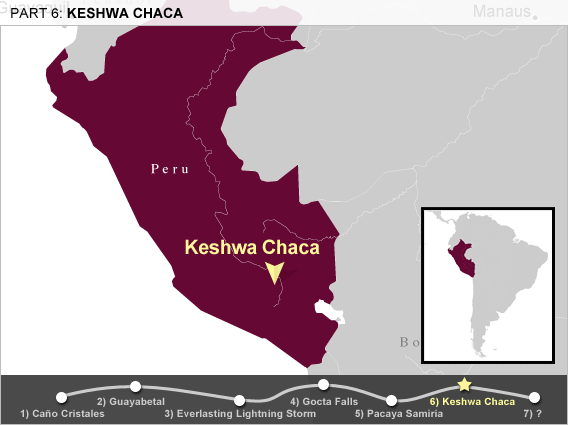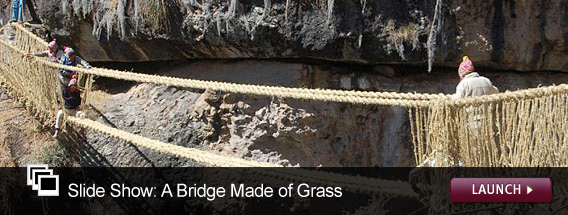The Last Incan Grass Bridge
The sixth hidden wonder of South America.
HUINCHIRI, Peru—The Incas didn't invent the wheel, never figured out the arch, and never discovered iron. But they were masters of fiber. They built ships out of fiber. (You can still find reed boats sailing on Lake Titicaca.) They made armor out of fiber, which was stronger, pound for pound, than the steel worn by the conquistadors. Their greatest weapon, the sling, was woven from fibers, and it was powerful enough to split a Spanish sword. They even communicated in fiber, developing a language of knotted strings known as quipo, which has yet to be decoded. And so when it came to solving a problem like how to get people and goods across the steep gorges of the Andes, it was only natural that the Incas would look to fiber for a solution.
Five centuries ago, the Andes were strung with suspension bridges. By some estimates, there were as many as 200 of them, braided from nothing more than twisted mountain grass and other vegetation, with cables that were sometimes as thick as a human torso. At least 300 years before Europe saw its first suspension bridge, the Incas were spanning longer distances and deeper gorges than anything that the best European engineers, working with stone, were capable of.
Over the centuries, most of the empire's grass bridges gradually gave way and were replaced with more conventional works of modern engineering. The most famous Incan bridge—the 148-footer immortalized by Thornton Wilder in The Bridge of San Luis Rey—lasted until the 19th century, but it, too, eventually collapsed. Today, there is just one Incan grass bridge left, the keshwa chaca, and just one last Incan bridge-keeper. His name is Victoriano Arisapana.
We drove four and a half hours south of Cusco with anthropologist Jean-Jacques Decoster to find Arisapana and the keshwa chaca. With the help of a hitchhiker who knew the route, we made our way down a series of hairpin curves to a sagging 90-foot-long bridge that stretched between two sides of a rocky canyon. According to locals, it has been there for at least 500 years.
Here in the desolate, 2-mile-high Andean altiplano, little else grows besides ichu, a tall needly grass that covers the mountainsides, feeds the llamas, and is the raw material from which the keshwa chaca is constructed. Unlike a modern suspension bridge, where the roadway hangs from suspended cables, the roadways of Incan bridges are the cables themselves. The keshwa chaca consists of just four parallel ropes with a mat of small twigs laid across, anchored at both ends by a platform of larger rocks. Two other thick cables act as arm rails and are connected to the roadway with a cobweb of smaller cord.

When we finally found him, the keeper of the last Incan bridge was tending his three cows on a barren hillside not far from the bridge. After sharing some coca leaves with us, and consecrating them to the spirit of the keshwa chaca, Arisapana guided us to his home, a tiny one-room mud brick house with a small garden.
Five centuries ago, at the height of the Incan empire, there would have been dozens, perhaps hundreds, of men like Arisapana throughout the Andes; they carried the title of chacacamayoc, or bridge-keeper. Each was responsible not only for maintaining and administering a bridge, but also for collecting tolls and helping frightened travelers across.
Exposed to the weather, thegrass ropes of the keshwa chaca wouldn't hold up for more than a couple of years. Unlike the Golden Gate or George Washington bridges, which are almost constantly being repaired, an Incan bridge can't be patched up or have parts swapped out. It can only be replaced wholesale. The largest Incan bridges were maintained by the state and supported by a system of compulsory public service that demanded several weeks' labor by every grown male each year. In the case of smaller communal bridges, like the keshwa chaca, the work of regularly rebuilding the bridge fell to local communities. To this day, the four surrounding villages convene in the valley each June for a three-day festival to cut down the previous year's keshwa chaca and replace it with cables twisted from fresh ichu. Each household is responsible for bringing 90 feet of braided cord to the ceremony. The entire process happens under the orchestration of the chacacamayoc, Arisapana.
Arisapana, who says he is 48, inherited the job of chacacamayoc from his father. Back at his home, he offered to show us how the bridge's grass rope is woven. He disappeared inside and came back a few minutes later with a bundle of fresh ichu, a plastic jug of water, and a stone slightly bigger than a softball. He sat down on a rock and demonstrated how the 2-foot-long blades of grass are first soaked and pounded to make them supple, and then twisted into cords as thick as a finger. Three dozen of those cords are braided together to form a rope about 6 inches in diameter. It takes about 10 miles of cord to make the entire bridge.
The first conquistadors to encounter grass bridges pronounced them "the work of the devil" and trembled at the thought of crossing. Ultimately, the Spanish discovered that the largest bridges were strong enough to carry not only horses but also cannons, as well as an army marching two-by-two. Indeed, modern load-testing by John Ochsendorf, an MIT professor and MacArthur fellow who researches the engineering accomplishments of ancient civilizations, has found that a length of keshwa chaca cable can sustain 4,000 pounds of tension. Ochsendorf estimates that in peak condition, the small bridge could support the weight of 56 people spread our evenly across its length.
Knowing that the strength of the keshwa chaca had been verified by no less of an authority than Ochsendorf and had been field-tested for no fewer than five centuries, I had no hesitation about stepping out onto the precarious-looking structure. It had been five months since the bridge had last been rebuilt, which meant it was almost halfway through its life cycle, and it was already showing wear. At its midpoint, the bridge sagged about 10 feet, and one of the arm rails had dropped about a foot lower than the other. Most of the small twigs that constitute the bridge's floor had long ago fallen into the Apurímac River, 60 feet below, which meant I had to step carefully to avoid dropping my foot through the floor. It was easy to imagine why even the bravest Spanish soldiers would sometimes crawl across on all fours. But as Dylan and I knew from our time in Colombia, there are scarier ways to cross an Andean valley.
In 1968, the government built a steel truss bridge just a few hundred yards upstream from the kewsha chaca. Though most locals now use it rather than the grass bridge to cross the gorge, the tradition of rebuilding the keshwa chaca each year still continues. Divorced from practical necessity, its annual renewal has become an impassioned, highly ritualized act of cultural preservation.
Today, the nearby metal truss bridge shows signs of wear. Its orange paint has grown rusty. Its wood planks are rickety. One of the metal barriers is badly warped from a vehicle collision. It was built as a permanent replacement for an inherently impermanent structure. But nothing is truly permanent. All bridges someday collapse. And it's not impossible to imagine that it may yet be outlived by its more fragile neighbor downstream, whose very ephemeralness seems to be the source of its staying power.
Click here to launch a slide show on a bridge made out of grass.
GoPro provided the travelers with some camera equipment free of charge.
For more on the world's wondrous, curious, and esoteric places, check out Atlas Obscura.

Like Slate on Facebook. Follow us on Twitter.

